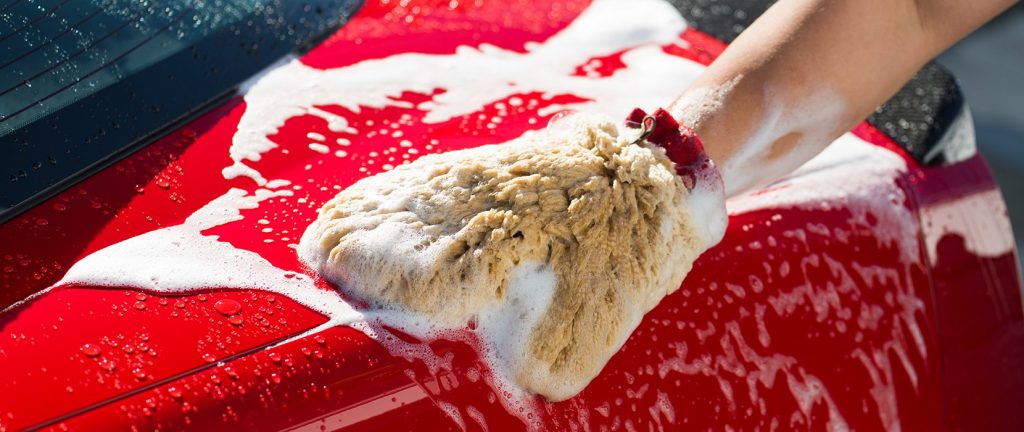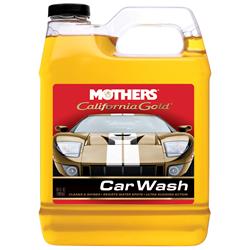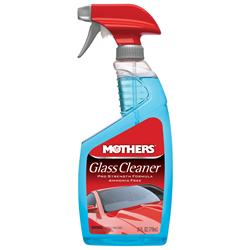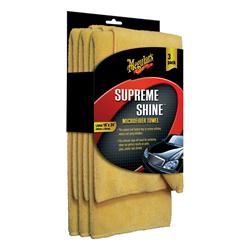
We don’t want to be “that guy.” You know the one—the guy who constantly tells you how to do your job (or how “you’re not doing it right.”)
So please think of this post as more of a public service message.
In conjunction with Mothers, Meguiar’s, and other automotive detailing experts, we’ve put together a list of common detailing mistakes and why you should avoid them. With a full season of car shows and cruises just beginning, it’s best to eliminate these mistakes now:
1. Washing in direct sunlight—or washing a car that’s hot.
We’re starting with the most obvious here.
It’s widely accepted among most detailing companies and professional detailers that you should NOT wash your car in direct sunlight. Some argue that it’s bad for your vehicle’s finish, but at the very least, it makes the job much, much harder. Because the water and cleaner/soap dries quicker in the sun or on a hot surface, you’re more likely to get water spots. And you may even notice swirl marks in your car’s paint after washing.
If you absolutely must wash your car in the sun, keep the surface cool with a regular spray of water.
2. Using your drying towel to remove dirt you missed during washing your car.
All you’re doing here is grinding the dirt into your finish.
By using your drying towel to remove dirt, you risk scratching your paint. And while we’re on the topic, you may want to pass on the squeegee for drying your vehicle’s surface. A squeegee can pick up and drag dirt into your paint.
3. Pouring waxes and polishes directly on the vehicle’s surface.
Don’t pour liquid waxes and polishes directly on the surface of your vehicle. This can lead to dark, uneven streaks in your finish. Instead, pour these types of the waxes and polishes directly on to your applicator.
4. Using solvent-based tire and rubber protectants.
Avoid solvent-based tire and rubber cleaners and protectants.
Mothers suggests checking your rubber cleaner bottle for distilled petrochemicals, which can adversely affect your tire’s surface integrity.
5. Cleaning your wheels and tires last.
Many of us were taught to clean our vehicle from the top down.
However, this does not include the wheels and tires.
In fact, you should clean your wheels and tires first, since they are most often the dirtiest parts on your vehicle. This will prevent you from splashing wheel well dirt and grime on your just-washed vehicle surface.
6. Using dish soaps or detergents.
Truth is, dish soaps are convenient and cheap to use, and they’re even somewhat effective at cleaning cars. In fact, they’re a little too good—harsh even. Dish soap and detergents are formulated to remove grease and wax and can strip away automotive waxes and sealers that are there to protect your vehicle’s finish.
Instead, use a purpose-made automotive wash.
7. Using ammonia-based glass cleaner.
Most household glass cleaners contain ammonia.
Ammonia not only stinks, but it can be damaging to upholstery and dashboard surfaces if spilled or dripped. Use an ammonia-free glass cleaner instead.
8. Treating stained upholstery areas only.
When you’ve got a nasty, dirty stain on your vehicle’s carpet, it’s only natural to focus time and energy on that one spot. But unless your vehicle is almost brand new, the entire upholstery is probably dirtier than you think. By cleaning just the individual dirty spots, you could wind up with a few very clean areas and the rest suddenly looking dirty.
That’s why it’s important to give attention to your entire interior instead of just particularly bad spots. Apply upholstery cleaner evenly to the entire area of your upholstery.
9. Treating all plastics the same.
Not all plastics are the same.
So don’t treat all your plastic surfaces the same. Mothers recommends using a penetrating protectant on soft plastics and dedicated plastic polish on harder surfaces like gauge cluster lenses.
10. Overwaxing.
Can you have overkill when waxing? Yes.
In most cases, two coats of wax will do the trick. The initial coat provides the foundation, and the second coat will cover any areas the first go-around may have missed. Any further coats will likely not adhere and will simply be wiped off with buffing.
11. Using a chamois for drying.
Please use a microfiber towel.
Microfiber towels will dry the surface while babying the finish. Chamois were once the go-to drying tool, but they contain very little nap to absorb left-over particles on the surface. The smoothness of the chamois will instead grind these particles back into the surface and create swirl marks.
It’s the same reason you shouldn’t use an old T-shirt to dry your precious vehicle.
12. Improper car towel cleaning.
Whether you use microfiber towels or simple, soft cotton towels, you’ll want to clean them properly after use. Don’t use a fabric softener—it can leave chemicals in the towels that are detrimental to your wax.




really great tips,thank you
This is so stupid, the author probably never did a car wash before
Well we all can’t be professional car wash jockeys like you!
Lighten up there pal.
Idk about you carlos, i already do most all these already. The one thing i did learn was about fabric softeners when washing microfiber towels. Oh and im sure ive been washing cars longer then you unless youve been showing semi trucks and heavy wreckers profetionally for almost 40 years. For the writers, thank you. Good tips for those who may not know everything.
Having a bad day there Carlos?
GREAT TIPS! THANX! Silly boys, TRUCKS ARE FOR GIRLS!
I let a hard rain clean My truck!
Twelve very good tips .
I’ll disagree with number 5. I use a a separate tire mitt for doing my wheels/tires last. if I did them first I’d be using contaminated water to wash my car. Other than that, spot on. Sorry, bad choice of words.
Good practice to use atleast 2 wash medis like you do
but use the 2 bucket wash system.
One 5 gallon bucket witu your soap the other with jist rinse water
both should have grit guards at the bottom lf each bucket
after you clean a section, dip sponge into rinse bucket prior to going back into wash bucket
The bucket for the wheels should have your brushes dipped in them while cleaning . You should then foam the car and use a mitt to agitate the soap and dirt . Then Another bucket with plain water to regularly rinse your mitt from dirt buildup
I did not know that!
Wash your car in the rain. Save money and time.
Use water if you want it to rust away before you trade it in for a new one.
there is nothing wrong with solvent based tire care products. Prove me wrong and show some proof on why they negatively affect surface integrity. Water based products don’t last as long
Lmao, use your head and think about it, these tire cleaners cause s chemical reaction that literally burns a layer golf the rubber off, leaving it soft and wet looking. If you can’t see the issue with that you probably shouldn’t be allowed to handle a hose let alone a car.
[…] car. The soapy residue will bake on, and the wax will dry too fast. So always be sure to do your detailing early in the morning while it is cooler outside or in the late afternoon. Or if you happen to be […]
I’ve always used two buckets,and wheels were always last on the cleaning list.
Don’t need any brake dust being ground back into the finish.
Actually I’d use the last of the clear water in the second bucket when doing the wheels.Also don’t throw out those old toothbrushes!They work great for nooks and crannies where wax seems to hide.
They also work great for getting into tight spots on custom wheels
The biggest tip of all is missing – NEVER EVER use a sponge for cleaning your car. It’s basically like using a sandpaper. Buy a microfiber mitt.
bwahaha….right.
Carwash Afi, I’m so glad you are the one person that knows what the biggest point is. Maybe GET YOUR OWN BLOG where you can put all your wisdom With vulgarity out there. Yep, that’s what we are missing today. Not.
With exterior black plastic parts. Like fenders on a Wrangler. I soak them with Black Restore or Back to Black right before I wax. Anyone who has accidentally dripped wax on those parts will know what I mean. Years of white wax stains.
Try staying away from retail based wax’s tend to be cheaper and do those. Try some professional grade wax’s
When I was a youngster, Many years ago, I worked for a service station that did a full hand car wash on any vehicle that had shop work done. The owner insisted that kerosene was added to the wash water. The vehicles did turn-out much shiney’er than when they came in! Of course this is way back when gas stations had bulk oil, kerosene, etc., in tanks with hand cranked pumps. Gas was around 23 cents a gallon for leaded regular
I’m an automotive painter, and I don’t disagree with any of these points. Although, if this is a used car that I feel needs to be polished to bring back the new paint look, I would use dish soap to do an initial cleaning on the cheap. But I would suggest “Detro Clean” to completely remove all contaminants from the surface before doing your first buff/polish. Detro Clean is especially good for wheels and tires, to clean road grime. I’ve used it to clean semi-truck frames which were caked in road-grime and oil/grease/dirt, etc. And while not advertised as a tire-dressing, I use Meguiars #40 to dress my tires because I don’t care for the “wet look”, and #40 gives tires that brand-new tire look–not shiny, just deep black.
Good tip on the #40, tried it, like you said, new not shiny. Just the look I like. Nice!
[…] 1. Avoid washing your car in the hot sun. The warmth can cause soap to dry on your vehicle, leaving stains on the car’s surface. If the heat is severe, cool water can even cause the car’s body to retract, which can crack the paint job. […]
I have used original formula Murphy’s Oil Soap for washing my vehicles for decades. The “soap” not only cleans the car, but the oil seeps into difficult to reach crevices and prevents rust. It even makes the paint “bead up” when it gets wet the next time. Have to dry the vehicle right away as it can leave spots.
While my vehicle is dripping wet after rinsing it, I spray the entire vehicle, glass and all, with detail spray. I then wipe the vehicle dry and this technique prevents water spots. It works like magic. Try it, you’ll be sold.
[…] If you are detailing your vehicle then you might be making any of the following […]
[…] 12 Common Car Detailing Mistakes—and Why You Should Avoid Them at All Costs! […]
[…] 12 Common Car Detailing Mistakes—and Why You Should Avoid Them at All Costs! […]
Thanks for the tips. Appreciate your taking the time to write it up.
I detail cars and my car is always spotless. Thank you for all your great tips and I agree with every single one !!
[…] Don’t wash your car in direct sunlight, no matter what the season, and no matter how often you see it being done. Doing so can make soap dry quickly, which will leave a residue. Use a garage to keep this from happening if it’s hot where you live. […]
[…] would advise you to avoid cleaning your car in sunlight. The reason behind this is that heat produced from the sun will dry up the water and soap left on […]
[…] 12 Common Car Detailing Mistakes—and Why You Should Avoid Them at All Costs! […]
[…] would advise you to avoid cleaning your car in sunlight. The reason behind this is that heat produced from the sun will dry up the water and soap left on […]
Great article! I agree I would definitely use a seperate mit to wash the tires and rims. My rims are always full of brake dust and I definitely like to do them last!
Without question the best product on the planet to remove brake dust on the wheels is awesome from the 99 cent store
[…] A lot of owners love to wash their cars when it’s hot, but this is not a very good idea as it can actually damage the paintwork. […]
Hi David, Great article on tips for avoiding common car detailing mistakes. I will surely consider these the next time I was my car.Do you have a favourite Chamois brand? Thanks!
I’m looking to do more detailing of my car. Now as you said here, there are some good tips that I should follow to avoid damaging my vehicle. I like the idea of cleaning the wheels and tires first as they are one of the dirtier parts of the vehicle.
Great tips for car owners! You don’t always need a professional to get the job done right 🙂
[…] If the ammonia drips inside the car, it can damage upholstery and the dashboard, according to the On All Cylinders automotive blog. […]
[…] If the ammonia drips inside the car, it can damage upholstery and the dashboard, according to the On All Cylinders automotive blog. […]
[…] If the ammonia drips inside the car, it can damage upholstery and the dashboard, according to the On All Cylinders automotive blog. […]
[…] If the ammonia drips inside the car, it can damage upholstery and the dashboard, according to the On All Cylinders automotive blog. […]
[…] Look for a spot with shade on a sunny day. This will keep metal surfaces inside and out cool (we’ve all had that seat belt buckle burn!), and prevent the interior from becoming stifling hot. Plus, it’ll keep your water from drying out and spotting before you have a chance to rinse and dry. […]
I know that I’ve been guilty of more than a few of these mistakes over the years. I’m getting ready to give my car a much-needed detail armed with your info!
Great tips! I would just like to emphasize that dish soap is not a car cleaner. It will oxidize your exterior and dull your paint’s finish. It might be a cheap and “effective” alternative, but it will also damage your car. Spend a few bucks on a proper car shampoo to make sure your car is in tip top shape.
GREAT TIPS! THANX! Silly boys, TRUCKS ARE FOR GIRLS!
[…] choose a period where your vehicle can be inactive for the entire day. You want to ensure that the engine is cooled completely before starting the process and allow ample time for it to dry before using it […]
[…] provided some insight here on how (and how not ) to wash and detail your […]
Great post.
Thanks for sharing.
I see people saying negative things about the Author of this post but as someone who has detailed professionally for 6 years and an enthusiast for 12 years I can say without a doubt that basically everything on this list is spot on. The only one I can’t say for sure on is the one about waxing too much. I’ve just never tried to wax a car “too many” times so I really have no clue as to whether that’s valid or not. Nowadays with ceramic coatings I tend to just avoid basic waxes most of the time unless it’s requested on top of an already ceramic coated surface. It gives a deeper “warmer” type of shine than ceramic alone does but the average guy, or in other words all of the haters commenting here,would never know the difference anyway. I don’t see anybody actually explaining what part of this post is wrong and the reasoning to accompany that but internet trolls know best right?
[…] If the ammonia drips inside the car, it can damage upholstery and the dashboard, according to the On All Cylinders automotive blog. […]
[…] If the ammonia drips inside the car, it can damage upholstery and the dashboard, according to the On All Cylinders automotive blog. […]
[…] If the ammonia drips inside the car, it can damage upholstery and the dashboard, according to the On All Cylinders automotive blog. […]
Great article. This helps me a lot. Hope you write more.
Excellent write-up, keep it coming. If you read and followed these steps you would have a scratch-free, clean car that would be easy to look after. Good stuff!